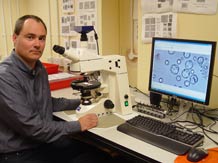
Dr José Iriarte looks at maize starch.
New research reveals earliest evidence for corn in the New World
A University of Exeter archaeologist is on an international team of scientists that has discovered the first direct evidence that maize was domesticated by 8,700 years ago, the earliest date recorded for the crop.
The research findings are published in the journal Proceedings of the National Academy of Sciences.
The study establishes tropical southwest Mexico as an important, but unexplored, region where early agriculture occurred in the New World.
Among the hundreds of plants that have been domesticated in the New World, none has received as much attention or been subject to as much debate as corn, or maize. Arguably the most important crop of the Americas, controversies have existed for years over what the wild ancestor of maize is and where and when it was domesticated.
Maize was originally domesticated in Mexico from a wild grass called “teosinte,” and genetic studies of modern populations of teosinte and maize suggested this event occurred somewhere in the Central Balsas Valley region of tropical southwest Mexico. However, no research on early prehistoric human settlement and agriculture had been carried out there until now.
The research team searched this region of Mexico for locations that showed human occupancy for the time period they thought to be critical to maize domestication, from approximately 8,000 to 9,000 years ago. They discovered sites dating to this age, excavated them and analyzed the stone tools and plant remains they retrieved. Microfossil (starch grain and phytolith) analysis from a rock shelter called Xihuatoxtla, conducted in part with Irene Holst at the Smithsonian Tropical Research provide direct evidence for the domestication of maize and a species of squash.
“Our findings confirm an early Holocene age for maize domestication and indicate that it is another important New World crop that had its origins in the tropical forest,” said Dr Dolores Piperno, archaeobotanist at the Smithsonian’s National Museum of Natural History, and lead author on the paper. “Much more work needs to be done in the Central Balsas region to investigate even earlier periods when teosinte must have been exploited by early human populations and then initially cultivated.”
Co-author Dr José Iriarte of the University of Exeter’s School of Geography, Archaeology and Earth Resources added: “This is the first time that maize domestication is documented in its cradle of origin. Our research used molecular studies, microfossil botanical analysis and state of the art palaeoecological techniques. The results represent a major advance in our understanding of early plant domestication and agricultural origins.”
The evidence corroborates a large quantity of previous research carried out in the lowland tropical forest south of Mexico by Piperno and other investigators that indicated maize spread to Panama approximately 7,600 years ago and was well established in northern South America about 6,000 years ago.
The archaeological record establishes tropical southwest Mexico as an important region where early agriculture occurred in the New World and adds maize to the roster of important cereals (others are wheat and barley from the Middle East) that were cultivated and domesticated by 9,000 years ago.
The team’s findings also contribute to the growing body of evidence that seasonally dry tropical forests were important centres of early human settlement and farming in the Neotropics. Early agriculture in this region of Mexico appears to have involved small groups of cultivators who were shifting their settlements seasonally and engaging in a variety of subsistence pursuits.
Date: 24 March 2009
